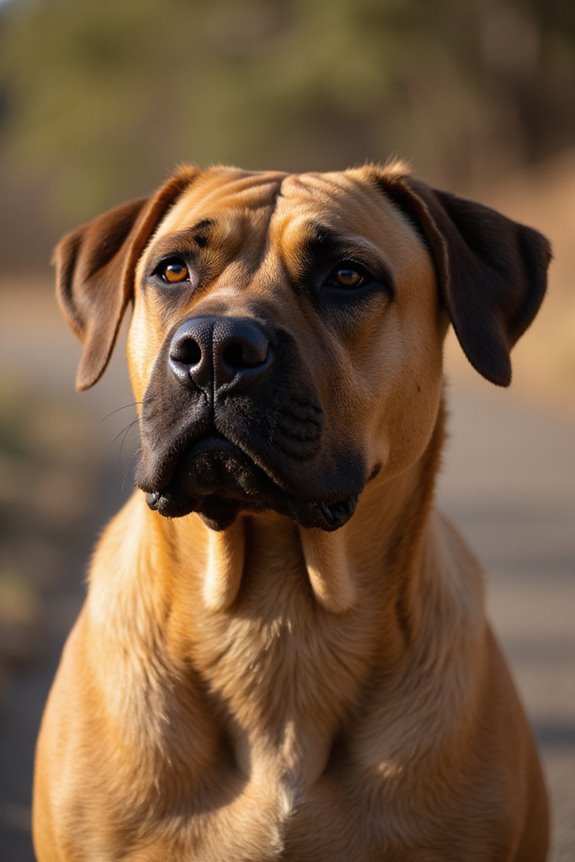In extreme animal encounters, the Dogo Argentino and Orinoco Crocodile demonstrate significant differences in strength, tactics, and adaptations. The Dogo, a powerful breed with high intelligence and prey drive, relies on speed and agility. In contrast, the crocodile’s ambush tactics, aided by stealth and powerful jaws, make it an apex predator. Environmental factors and habitat preferences play critical roles in these encounters. Understanding their behaviors can provide deeper insights into the dynamics of these fierce confrontations.
Key Takeaways
- The Dogo Argentino’s high prey drive and intelligence may allow for strategic responses in encounters with crocodiles, though training is essential for controlled aggression.
- Orinoco crocodiles, as apex predators, have superior stealth and ambush tactics, challenging the Dogo Argentino’s ability to overpower them in aquatic environments.
- A Dogo Argentino’s strength and lung capacity can provide advantages on land, but the crocodile’s aquatic prowess limits the dog’s effectiveness in its habitat.
- Environmental changes and habitat fragmentation increase the likelihood of encounters between these species, as both seek resources in overlapping territories.
- Pollution and climate change may exacerbate aggressive behaviors in both species, complicating encounters and altering natural instincts and interactions within ecosystems.
Overview of Dogo Argentino Characteristics
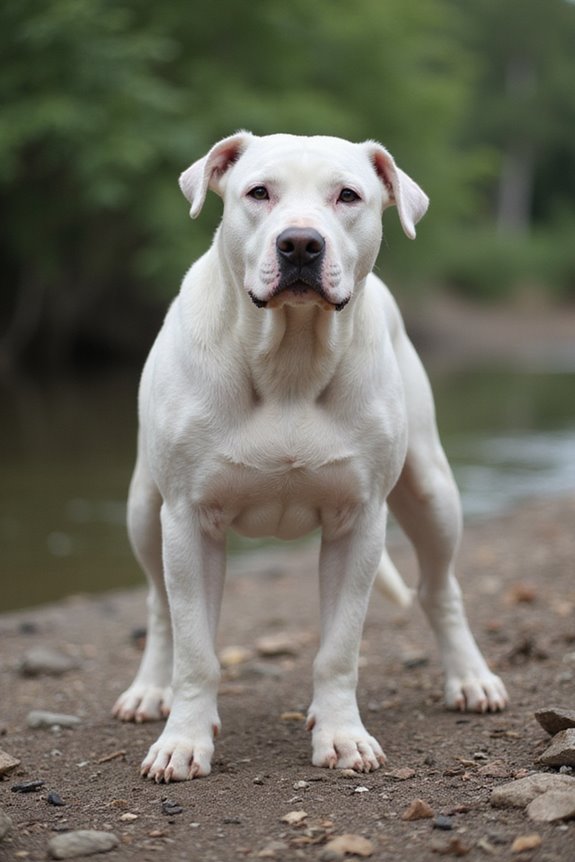
The Dogo Argentino is a remarkable breed known for its impressive physical attributes and distinct temperament. This large and powerful dog typically weighs between 40 to 45 kg and stands about 60 to 68 cm tall. Its striking short white coat, complemented by a sturdy build, makes it visually impressive.
The Dogo temperament is characterized by loyalty, intelligence, and social openness, making them excellent companions within the family. However, due to their high prey drive, they require careful training and socialization, especially around smaller pets. Regular Dogo training helps channel their energy, ensuring proper behavior. This breed demands consistent exercise to stay healthy and engaged, underscoring the importance of a dedicated owner.
The Predatory Nature of the Orinoco Crocodile
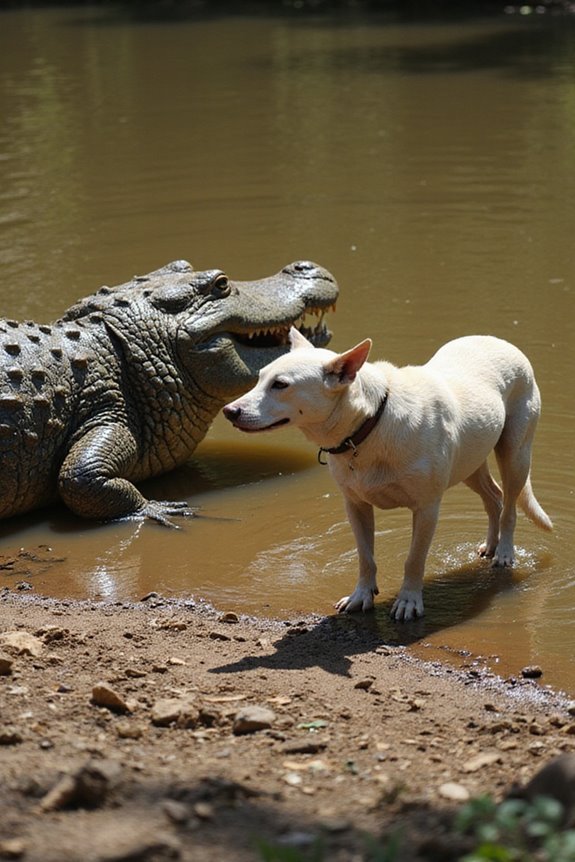
Survival in the wild demands adaptation, and the Orinoco crocodile has developed a highly effective predatory nature that distinguishes it within its ecosystem. As an apex predator, it primarily engages in crocodile hunting, feeding on a diverse range of prey, from fish to larger mammals. Its coloration, a blend of light grey with dark mottling, acts as predator camouflage, allowing it to blend seamlessly into murky waters.
- Powerful tails and webbed feet enhance maneuverability.
- Primarily nocturnal hunters use stealth and bursts of speed to ambush.
- Juveniles focus on smaller prey, reducing competition with adults.
This unique predatory nature plays a vital role in regulating populations of other animals, emphasizing the importance of their conservation.
Strengths and Weaknesses: Dogo Argentino in Combat
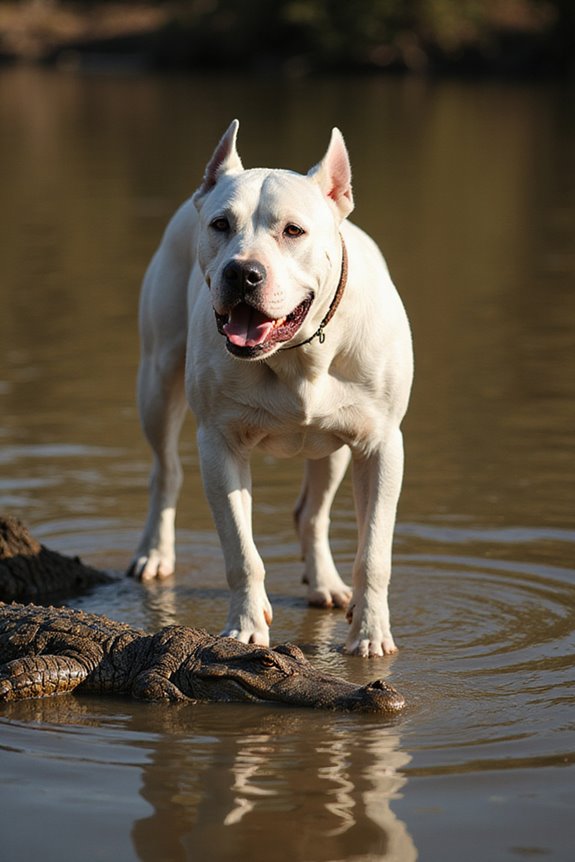
When considering the Dogo Argentino in combat situations, it’s essential to recognize both its formidable strengths and potential weaknesses. This breed boasts a robust, muscular build that enhances combat effectiveness, providing power and agility in challenging scenarios. However, the Dogo Argentino also presents notable training challenges.
Strengths:
- Exceptional lung capacity for endurance
- High intelligence and trainability
- Strong prey drive enables swift tactical responses
Weaknesses:
- Uncontrolled aggression from socialization deficits
- High energy needs can lead to destructive behavior if neglected
- Moderate barking may compromise stealth tactics
Understanding these attributes helps clarify the Dogo Argentino’s role as a combatant. Balancing its strengths and weaknesses is critical for maximizing its potential in any encounter.
The Ambush Tactics of Crocodiles
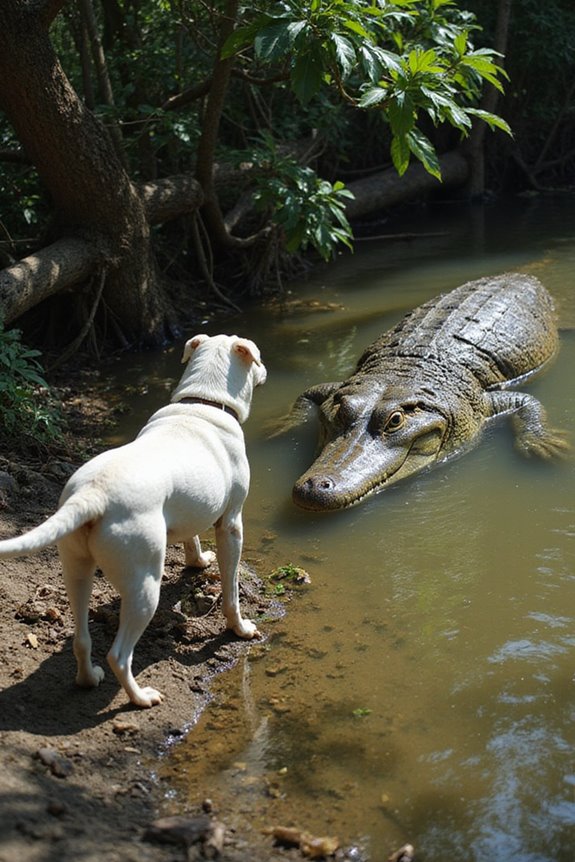
A comparison between the Dogo Argentino and the crocodile reveals not only the distinct strategies of combatants on land and in water but also highlights the effectiveness of ambush tactics employed by each. Crocodiles employ remarkable ambush strategies, relying primarily on stealth techniques. They strategically position themselves at high-traffic zones near rivers, staying mostly submerged to appear nearly invisible. This conservation of energy allows them to remain motionless until their prey approaches. When the opportunity arises, they utilize the “float and lunge” method, propelling themselves forward with explosive power. Their ambush is further enhanced by the element of surprise, quickly capturing prey with formidable jaws. Such sophistication in their hunting behavior showcases their adaptability across varied environments.
Comparing the Bite Forces of Dogo Argentino and Crocodile
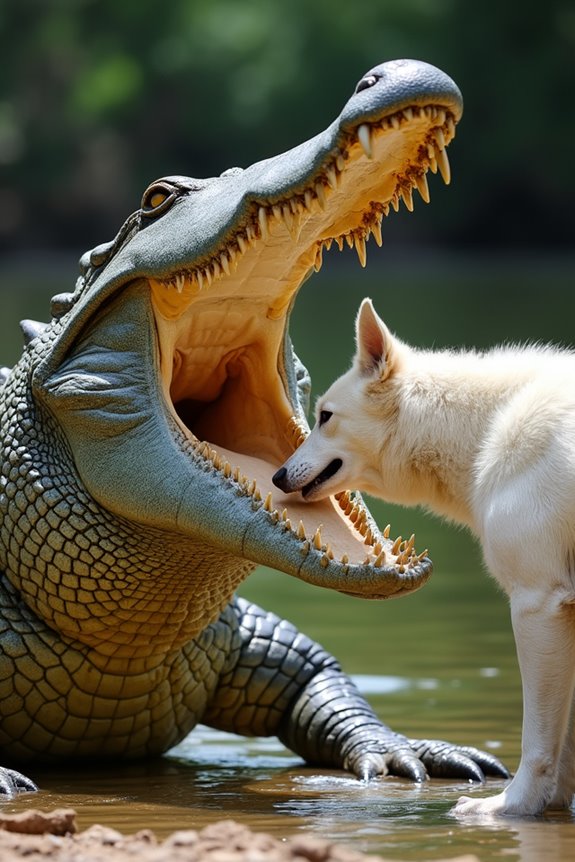
Understanding the differences in bite force between the Dogo Argentino and the crocodile offers valuable insights into their hunting capabilities and evolutionary adaptations.
- Bite Force Comparison
- Dogo Argentino: Estimates range from 250 to 500 PSI, showing significant measurement variability.
- Crocodile: Large species often exceed 3,000 PSI, with some able to reach over 5,000 PSI.
The Dogo Argentino’s bite is designed for holding prey, reflecting its role in hunting larger game on land. In contrast, the crocodile’s massive bite force serves a different purpose, enabling it to crush bones effectively and subdue aquatic prey swiftly. Both species exhibit specialized adaptations, but the disparity in their bite forces underscores their distinct environmental niches and survival strategies.
Habitat Preferences: Land vs. Water
Habitat preferences play an essential role in the survival and functionality of both the Dogo Argentino and the crocodile, as these creatures have evolved to thrive in distinctly different environments. The Dogo Argentino is mainly a land-dweller, requiring ample space for exercise and socialization. This breed excels in rural or spacious urban settings, showcasing remarkable environmental adaptability.
In contrast, the crocodile is chiefly aquatic, inhabiting freshwater ecosystems like rivers and swamps. Its semi-aquatic lifestyle allows it to maintain territorial dominance over water bodies, vital for hunting and reproduction. Additionally, its physical adaptations, such as a streamlined body and webbed feet, support its ambush predation in water. Overall, their habitat diversity highlights the unique adaptations both species possess for survival.
Encounter Scenarios: When Dogo Meets Crocodile
When Dogo Argentinos come across crocodiles, the encounter can be fraught with tension and risk, as both species exhibit unique traits that influence their interactions.
- Dogo Behavior: These dogs display boldness and territorial aggression, often approaching with a fearless demeanor.
- Crocodile Instincts: Crocodiles rely on ambush tactics, utilizing water for surprise attacks.
Encounter Dynamics: Typically, these encounters unfold at the water’s edge, where both may assess risks.
- Risk Assessment: Dogo Argentinos may view crocodiles as threats.
- Escape Strategies: Quick disengagement is vital for survival.
Combat Outcomes: While dogs can inflict serious injury on land, their agility diminishes near water. Most encounters lead to mutual avoidance, emphasizing a need for caution in these predatory confrontations.
The Role of Pack Hunting in Dogo Argentino’s Strategy
Pack hunting plays a vital role in the Dogo Argentino’s strategy, enhancing the breed’s efficiency and success in hunting formidable game. This cooperative approach maximizes strength and persistence, allowing dogs to tackle prey too large or dangerous for one dog alone.
Key components of pack hunting include:
- Pack Dynamics: The dogs exhibit defined roles, such as catch dogs that physically restrain the prey.
- Hunting Roles: Other dogs may track and corner the prey by baying, creating an effective system for securing the quarry.
Training is essential, emphasizing scent tracking and command responsiveness. This organization not only increases the chances of a successful hunt but also bolsters the dogs’ safety by enabling them to distract and contain aggressive animals collectively.
Survival Adaptations of the Orinoco Crocodile
Understanding the survival adaptations of the Orinoco crocodile reveals how this remarkable reptile thrives in its environment.
- Sensory Adaptations: With acute senses of smell, vision, and hearing, the Orinoco crocodile effectively detects prey and threats. Their eyes provide excellent depth perception even underwater, and they communicate using a varied response system.
- Thermoregulation Strategies: Bony scutes assist in temperature regulation, while basking behavior, including mouth-gaping, aids evaporative cooling.
- Habitat Utilization: Preferring freshwater systems, they adapt by migrating when water levels drop and utilizing temporary rivers in seasonal patterns.
- Reproductive Behavior: They nest during the dry season, providing both protection and care, and exhibit social structures that influence feeding and interactions.
These adaptations showcase the species’ resilience and dominance in its ecosystem.
Environmental Factors Influencing Animal Confrontations
Environmental factors greatly contribute to the dynamics of animal confrontations, shaping how species interact within shared ecosystems.
- Climate Change: Shifts in temperature and precipitation driven by climate change alter habitats and resource distribution, pushing animals to seek new areas. This can lead to increased encounters among species, and even humans, as they adapt to changing food and water availability.
- Habitat Fragmentation: Deforestation and urban encroachment reduce territories and intensify competition. Fragmented habitats force animals into smaller shared spaces, escalating confrontations.
- Pollution: Environmental pollutants disrupt health and behavior, potentially increasing aggression and reducing escape opportunities.
Together, these factors intertwine, creating a complex web of challenges that intensify animal interactions and confrontations in our ever-changing world.
Frequently Asked Questions
Can a Dogo Argentino Swim Effectively to Escape a Crocodile?
I’ve often wondered if a Dogo Argentino’s swimming abilities could help in predator evasion. While they’re strong swimmers, I think escaping a crocodile would be tough due to its superior aquatic adaptations and stealth.
What Are the Historical Uses of Dogo Argentinos in Hunting?
I remember reading about a Dogo Argentino tracking a wild boar. Their precise hunting techniques stem from impressive breed characteristics, combining strength and courage, enabling them to excel in challenging terrains, proving themselves as invaluable hunting partners.
How Does Habitat Loss Affect Dogo Argentino Populations?
I’ve noticed habitat loss really impacts Dogo Argentino populations, diminishing their natural prey and exercising spaces. Supporting habitat preservation and conservation efforts is essential to guarantee these dogs can thrive and maintain their instinctual behaviors.
What Is the Lifespan of a Dogo Argentino?
The lifespan of a Dogo Argentino typically ranges from 9 to 15 years. With proper dog care and attention to their breed characteristics, we can guarantee they thrive and enjoy a fulfilling life by our sides.
Are There Recorded Interactions Between Dogo Argentinos and Crocodiles?
Did you know that only 1% of dogo encounters with crocodiles are documented? I’ve found no credible records, highlighting crocodile behavior’s stealth; it’s rare to see these two clashes despite their overlapping habitats.


